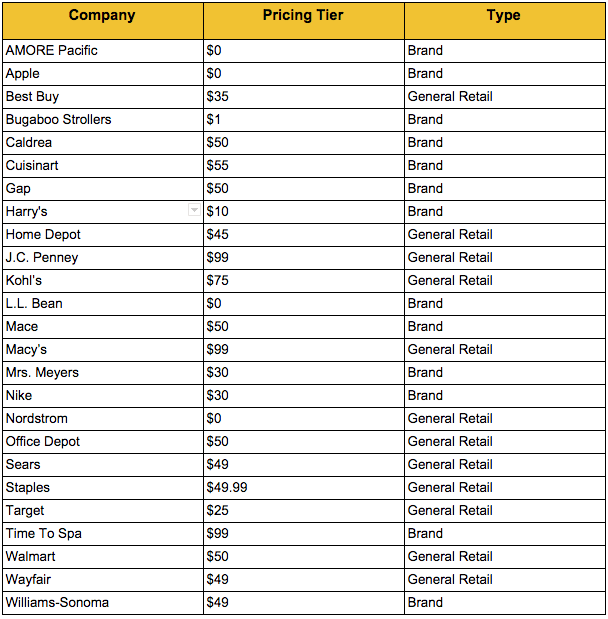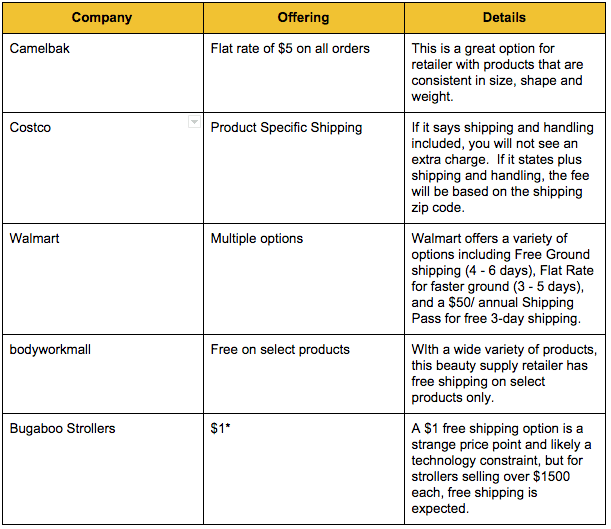Shipping costs are a key decision criteria for e-commerce buyers. A recent study by Visual Website Optimizer highlights this fact: “at 28%, unexpected shipping cost is the biggest reason for cart abandonment among online shoppers†from VWO eCommerce Survey 2014. Not surprising, but in a recent Pitney Bowes study, 93% of e-commerce shoppers want shipping options and rewards.
When it comes to shipping offerings, there is no best offering, but there are a lot of different options. In this article, we explore some of the options offered by leading e-commerce companies. About 18 months ago, we wrote a blog post on free shipping and whether it was a requirement or not. Since writing that post, the trend of offering free shipping has accelerated. Customers expect total cost transparence when doing online purchases, and free shipping is an important part of an e-commerce purchase cost. As a result, free shipping has become a pretty standard offering. With few exceptions, most major retailers and brands have some form of free shipping option available on their e-commerce sites. Often the free shipping is based on purchase tiers, where free shipping is available to customers that make a purchase over a specific amount. For example, under $50 and shipping is offered at a flat rate of $7, and over $50, shipping is free.
Determining your shipment pricing strategy is a key part of setting up any e-commerce store. Â There are a number of implications that need to be considered.
1. There are a number of financial considerations. Will product margins cover the cost of free shipping? As an e-commerce merchant, there are a number of major financial components that go into determining free shipping options. What pricing tier will balance revenues and costs? Is there a difference in sales volume and abandoned carts with free shipping tiers at $50 versus at $29?
There are a lot of different free shipping thresholds being offered by e-commerce companies. Branded manufacturers, especially in categories with higher product price points (e.g. cosmetics), are able to have lower shipping thresholds since their margins can cover the shipping costs more easily.
Based on a review of 25 major e-commerce sites (see below), on average, brands offer free shipping on purchases that are on average $19.55 (37.48%) less than general retailers:
Clearly the margins for brands are higher than for retailers, and there is flexibility to offer free shipping at lower values.
2. Product type is a major consideration. Small and light products that are expensive  (e.g. vitamins, jewelry, cosmetics) are perfect candidates for free shipping. Heavier / bulky and cheaper products (e.g. soaps, cans, liquids, etc.) are not. Typically, e-commerce merchants face a dilemma when their product offering includes both types of products. There is no right answer on how this product mix issue can be resolved, but modeling of your historic order mix can certainly help drive an informed decision. There is also the option to have exclusions on certain products, where some products ship free and others have a shipping surcharge.
3. Shipping Contracts play a big role in the financial model. Companies that have been able to negotiate preferred rates with their shipment providers have more flexibility in where they set their threshold rates.
4. Geography is a major consideration when defining shipping options as it can have major cost implications. Since Geographic shipping options typically breakdown into the following groupings for US based sites:
- Contiguous US states (including District of Columbia)
- Hawaii and Alaska
- Canada
- APO / FPO / DPO (military and diplomatic mail)
- Other (this category is a catch-all  and often covers the Caribbean, South America, and the rest of the world)
Given the variations in shipping costs and the distribution of the US population, a review of the Shipping Terms & Conditions shows that free shipping options only apply to “ship to†destinations in the contiguous US states.
5. Is free shipping a permanent offering or a promotion? Free shipping can be set up as either a permanent element of your e-commerce site, or a special promotion. There are  implications to both. When a customer gets free shipping on your site once for a purchase, they expect to always get free shipping. This decision can have an impact on future customer purchases and the lifetime value of the customer.
6. Technology can play an important role in deciding if free shipping is offered and in what circumstances. Platforms such as Magento, have robust shipping capabilities, and extensions that can be used to enhance the core shipping capabilities. As an e-commerce agency, we deal with shipping options constantly, and we have developed a series of e-commerce best practices and Magento tools for implementing shipping rules and options. Invariably some customization is required, but the technology you use for your e-commerce platform should not limit the shipping business rules that you need to implement.
There is no “one size fits all†set of business rules for shipping tiers. The following table highlights the spread of free shipping tiers as well as the merchant type.
There are always variations in how different companies handle shipping charges. Some interesting examples:
THE BOTTOM LINE
Shipping is a critical factor in driving sales and profitability and needs to be a strategic  consideration when setting up your e-commerce store and optimizing it. If you have a free shipping tier that is too low, your margins get eroded; too high and sales can be impacted. Striking the balance is critical.  Need help with your e-commerce shipping strategy? Let’s talk.





